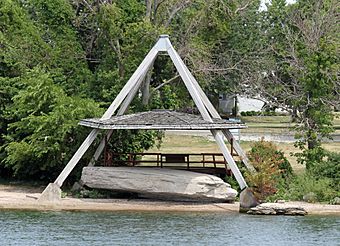Inscription Rock (Kelleys Island, Ohio) facts for kids
Quick facts for kids |
|
|
Inscription Rock
|
|

Inscription Rock
|
|
| Nearest city | Kelleys Island, Ohio |
|---|---|
| Area | less than one acre |
| NRHP reference No. | 73001432 |
| Added to NRHP | June 18, 1973 |
Inscription Rock is a very old and special rock found on Kelleys Island. This island is located in Lake Erie in Erie County, Ohio. The rock is a large piece of limestone, about 32 feet long and 21 feet wide.
You can find Inscription Rock on the south side of the island. It is covered by a big shelter, and there's a platform where you can view it. This makes it easy for everyone to visit and see the ancient carvings. In 1973, Inscription Rock was added to the National Register of Historic Places. This means it's an important historical site that should be protected.
Long ago, there were other interesting things near the rock. People found crescent-shaped mounds, which are believed to have been built by ancient peoples before Christopher Columbus arrived. There was even another rock with carvings on the north side of the island. This second rock was made of granite and had two upside-down figures carved into it. Sadly, quarry workers on the island later destroyed this granite rock. So, Inscription Rock is the only one left today.
Discovering Inscription Rock
Inscription Rock was found in 1833. It was partly buried in the sand along the lake shore. By 1915, it was so famous that pictures of it appeared on postcards for tourists. Even today, many people visit this amazing site.
In 1851, a man named Colonel Eastman from the United States Army was asked to study the rock. He made detailed drawings of all the carvings. Then, he sent copies of these drawings to Shingvauk. Shingvauk was a Native American who understood ancient picture writing.
What the Carvings Show
There are more than 100 images carved into Inscription Rock. Experts noticed that these carvings look similar to those used by the Iroquois people in Canada. The rock is made of soft limestone. Because of this, most experts believe the carvings are less than 1,000 years old.
Even so, Inscription Rock is one of the most important examples of ancient carvings by Native Americans in the area. It is also easy for people to visit and learn from. However, because the rock is so close to Lake Erie, it is slowly wearing away. Wind and waves from the lake cause this erosion.
Gallery














